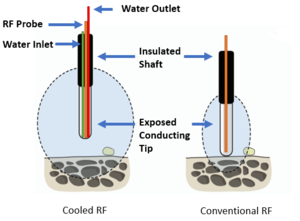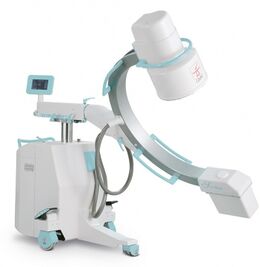Radiofrequency Neurotomy: Difference between revisions
No edit summary |
|||
| (10 intermediate revisions by the same user not shown) | |||
| Line 1: | Line 1: | ||
{{stub}} | {{stub}} | ||
[[File:C arm.jpg|267x267px|thumb|right|A C-arm is used to guide needle placement under fluoroscopy]] | |||
Radiofrequency neurotomy (RFN), also known as radiofrequency ablation (RFA) involves using an alternating current of high frequency radio waves to treat pain from an innervated structure. | |||
The waves produce ion movement which creates friction and the energy is dissipated as heat. Heating nerve tissue >45 degrees causes neural blockade, and heating to 60-100 degrees induces protein coagulation and tissue death. Conventional RF lesion done at 80-85 degrees for 60-90 seconds. Placement is confirmed normally by fluoroscopy. Sensory +/- motor testing can be done but this is controversial and is not generally done in New Zealand. The most important thing is having the patient awake so they can inform you of any unwanted symptoms has the probe heats up. When using traditional radiofrequency, probe placement '''must''' be parallel to the target nerve. This is the technique used in New Zealand, but unfortunately many centres overseas do not do this and this greatly reduces benefit. Pain often recurs after ~400 days when it comes to medial branch neurotomy, but the procedure can be repeated. | |||
== History == | |||
See review by Russo et al.<ref>{{Cite journal|last=Russo|first=Marc|last2=Santarelli|first2=Danielle|last3=Wright|first3=Robert|last4=Gilligan|first4=Chris|date=2021|title=A History of the Development of Radiofrequency Neurotomy|url=https://pubmed.ncbi.nlm.nih.gov/34992451|journal=Journal of Pain Research|volume=14|pages=3897–3907|doi=10.2147/JPR.S334862|issn=1178-7090|pmc=8714970|pmid=34992451}}</ref> | |||
==Indications== | ==Indications== | ||
Generally for nociceptive pain: shut off nociceptive afferents from the painful structure (but not selective). Diagnosis should be confirmed with two positive diagnostic blocks. A single positive block can have a high false positive due to the placebo effect. RF is not indicated for central pain, spinal cord pathology, serious psychological factors, or when confident pain ratings are not possible. | Traditionally it has only been used to treat chronic facet joint mediated pain in those who have confirmed facet joint pain as diagnosed by medial branch blocks. More recently we have seen much expanded use, but this expanded use has not occurred in New Zealand. | ||
=== General Indications === | |||
*Generally for nociceptive pain: shut off nociceptive afferents from the painful structure (but not selective). | |||
*Diagnosis should be confirmed with two positive diagnostic blocks. A single positive block can have a high false positive due to the placebo effect. | |||
*RF is not indicated for central pain, spinal cord pathology, serious psychological factors, or when confident pain ratings are not possible. | |||
*In New Zealand it is mostly used for the treatment of confirmed chronic facet joint pain. | |||
=== Specific Structures === | |||
Only the first two are routinely done in New Zealand and have the most evidence. | |||
* Cervical medial branches | |||
* Lumbar medial branches | |||
* Lateral sacral branches | |||
* Thoracic medial branches | |||
* Knee joints | |||
* Hip joints | |||
* Occipital nerve branches | |||
[[Category:Precision Techniques]] | [[Category:Precision Techniques]] | ||
==Cooled vs Conventional Radiofrequency== | ==Cooled vs Conventional Radiofrequency== | ||
[[File:Cooled | [[File:Cooled_vs_Conventional_RF.png|alt=|thumb|300x300px|Cooled versus conventional RF. Image modified from Patel 2016<ref>Patel N. Twelve-Month Follow-Up of a Randomized Trial Assessing Cooled Radiofrequency Denervation as a Treatment for Sacroiliac Region Pain. Pain Pract. 2016;16(2):154-167. doi:10.1111/papr.12269</ref>]] | ||
Cooled radiofrequency probes have a special tip allowing cold saline to run through it. It is cooled, but not cold. i.e. it is not about freezing the tissue. | |||
The water cooling with saline decreases charring of structures immediately adjacent and allows the extension of the heated field. More energy is able to reach the nervous tissue. | |||
Energy transfers to a relatively large field (8-10mm), even distal to the probe tip. Energy transfer through a conventional probe is only 3-4mm, and does not extend distal to the probe. The shape in other words is different, with a spherical lesion for cooled, and elliptical lesion for conventional. With a conventional probe, heating must be done adjacent to any nerve. This is not necessary with a cooled probe, allowing a greater variety of approaches. | |||
Go to the articles in the see also section for the evidence behind its utility. It is superior to conventional radiofrequency for sacroiliac joint (due to the variable nerve course) and lumbar disc denervation (due to the larger field), but is equal when it comes to lumbar facet joint denervation when done with correct technique. | |||
==See Also== | ==See Also== | ||
| Line 26: | Line 45: | ||
*[[Lumbar Facet Joint Precision Treatment]] | *[[Lumbar Facet Joint Precision Treatment]] | ||
*[[Lumbar Disc Precision Treatment]] | *[[Lumbar Disc Precision Treatment]] | ||
*[https://pubmed.ncbi.nlm.nih.gov/34526815/ American Society of Pain and Neuroscience RFN guidelines] - open access | |||
*[https://www.spineintervention.org/general/custom.asp?page=Guidelines Spine Intervention Society RFN guidelines] - closed access | |||
*Pain Medicine article - https://doi.org/10.1111/pme.12566 | |||
==References== | ==References== | ||
Latest revision as of 19:15, 24 March 2022
Radiofrequency neurotomy (RFN), also known as radiofrequency ablation (RFA) involves using an alternating current of high frequency radio waves to treat pain from an innervated structure.
The waves produce ion movement which creates friction and the energy is dissipated as heat. Heating nerve tissue >45 degrees causes neural blockade, and heating to 60-100 degrees induces protein coagulation and tissue death. Conventional RF lesion done at 80-85 degrees for 60-90 seconds. Placement is confirmed normally by fluoroscopy. Sensory +/- motor testing can be done but this is controversial and is not generally done in New Zealand. The most important thing is having the patient awake so they can inform you of any unwanted symptoms has the probe heats up. When using traditional radiofrequency, probe placement must be parallel to the target nerve. This is the technique used in New Zealand, but unfortunately many centres overseas do not do this and this greatly reduces benefit. Pain often recurs after ~400 days when it comes to medial branch neurotomy, but the procedure can be repeated.
History
See review by Russo et al.[1]
Indications
Traditionally it has only been used to treat chronic facet joint mediated pain in those who have confirmed facet joint pain as diagnosed by medial branch blocks. More recently we have seen much expanded use, but this expanded use has not occurred in New Zealand.
General Indications
- Generally for nociceptive pain: shut off nociceptive afferents from the painful structure (but not selective).
- Diagnosis should be confirmed with two positive diagnostic blocks. A single positive block can have a high false positive due to the placebo effect.
- RF is not indicated for central pain, spinal cord pathology, serious psychological factors, or when confident pain ratings are not possible.
- In New Zealand it is mostly used for the treatment of confirmed chronic facet joint pain.
Specific Structures
Only the first two are routinely done in New Zealand and have the most evidence.
- Cervical medial branches
- Lumbar medial branches
- Lateral sacral branches
- Thoracic medial branches
- Knee joints
- Hip joints
- Occipital nerve branches
Cooled vs Conventional Radiofrequency

Cooled radiofrequency probes have a special tip allowing cold saline to run through it. It is cooled, but not cold. i.e. it is not about freezing the tissue.
The water cooling with saline decreases charring of structures immediately adjacent and allows the extension of the heated field. More energy is able to reach the nervous tissue.
Energy transfers to a relatively large field (8-10mm), even distal to the probe tip. Energy transfer through a conventional probe is only 3-4mm, and does not extend distal to the probe. The shape in other words is different, with a spherical lesion for cooled, and elliptical lesion for conventional. With a conventional probe, heating must be done adjacent to any nerve. This is not necessary with a cooled probe, allowing a greater variety of approaches.
Go to the articles in the see also section for the evidence behind its utility. It is superior to conventional radiofrequency for sacroiliac joint (due to the variable nerve course) and lumbar disc denervation (due to the larger field), but is equal when it comes to lumbar facet joint denervation when done with correct technique.
See Also
- Sacroiliac Joint Precision Treatment
- Lumbar Facet Joint Precision Treatment
- Lumbar Disc Precision Treatment
- American Society of Pain and Neuroscience RFN guidelines - open access
- Spine Intervention Society RFN guidelines - closed access
- Pain Medicine article - https://doi.org/10.1111/pme.12566
References
- ↑ Russo, Marc; Santarelli, Danielle; Wright, Robert; Gilligan, Chris (2021). "A History of the Development of Radiofrequency Neurotomy". Journal of Pain Research. 14: 3897–3907. doi:10.2147/JPR.S334862. ISSN 1178-7090. PMC 8714970. PMID 34992451.
- ↑ Patel N. Twelve-Month Follow-Up of a Randomized Trial Assessing Cooled Radiofrequency Denervation as a Treatment for Sacroiliac Region Pain. Pain Pract. 2016;16(2):154-167. doi:10.1111/papr.12269


